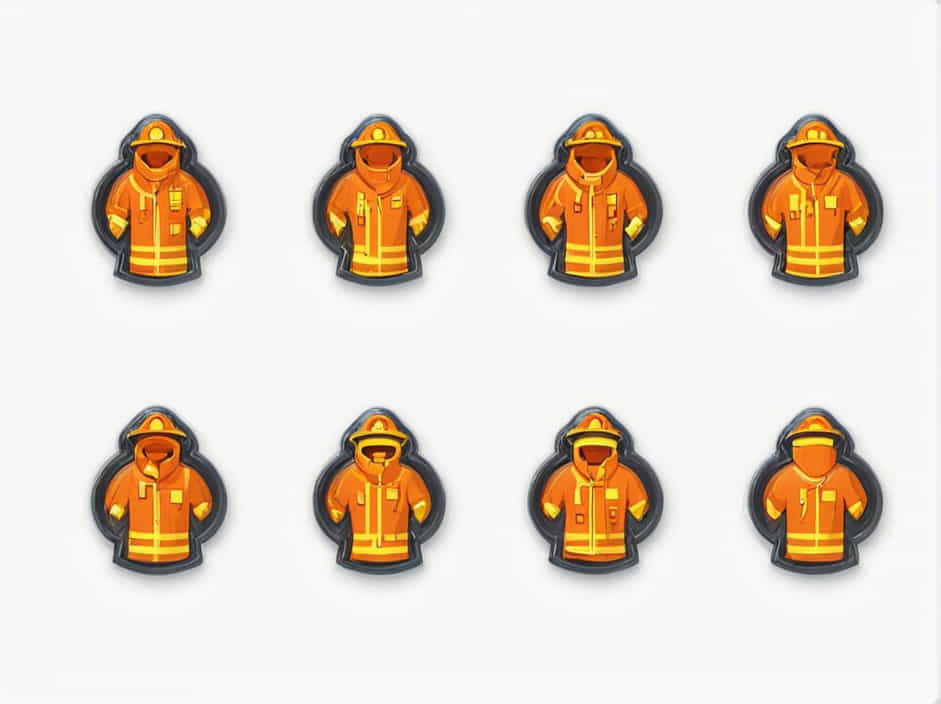Firefighters face extreme conditions, including high temperatures, flames, smoke, and toxic gases. To protect them from these dangers, their uniforms are coated with specialized fire-resistant materials. These coatings play a crucial role in preventing burns, reducing heat absorption, and providing durability in hazardous environments.
This topic explores the materials used to coat firefighter uniforms, their protective properties, and how they enhance safety in firefighting operations.
Why Firefighter Uniforms Require Special Coatings
Firefighters encounter intense heat, open flames, and hazardous chemicals during rescue operations. Without proper protective gear, they risk severe burns, heat exhaustion, and exposure to toxic substances.
The uniform’s coating serves several important functions:
✔ Fire Resistance – Prevents ignition and slows down burning.
✔ Heat Insulation – Reduces heat absorption to protect the firefighter’s body.
✔ Water and Chemical Resistance – Repels water, hazardous chemicals, and debris.
✔ Durability – Extends the uniform’s lifespan by withstanding harsh conditions.
Firefighter uniforms are made with multiple layers, each serving a specific purpose to enhance safety, comfort, and mobility.
What is a Firefighter’s Uniform Coated With?
Firefighter uniforms are coated with fire-resistant (FR) materials, ensuring they can withstand extreme temperatures. The main coatings used include:
1. Nomex Coating
Nomex is a heat-resistant synthetic fiber developed by DuPont. It is one of the most common materials used in firefighter uniforms due to its:
✔ Flame Resistance – Does not melt or drip when exposed to fire.
✔ Durability – Retains its protective properties even after multiple washes.
✔ Lightweight Design – Enhances mobility without compromising safety.
Nomex fibers are woven into the fabric and coated to provide additional thermal protection, making them essential in fire-resistant gear.
2. Kevlar Coating
Kevlar is another high-strength synthetic fiber known for its heat resistance and durability. It is often combined with Nomex to create a strong, fireproof fabric.
✔ High Tensile Strength – Resistant to tearing and punctures.
✔ Fire and Heat Protection – Does not burn easily and provides insulation.
✔ Lightweight – Allows firefighters to move quickly and efficiently.
Kevlar coatings increase the uniform’s durability, ensuring it can withstand repeated exposure to intense heat and physical stress.
3. Polybenzimidazole (PBI) Coating
Polybenzimidazole (PBI) is a high-performance fiber used in fire-resistant fabrics. It is commonly used in high-risk firefighting operations due to its:
✔ Superior Thermal Stability – Can withstand temperatures up to 700°F (370°C).
✔ Resistance to Breaking Down – Does not degrade when exposed to flames or chemicals.
✔ Comfort and Flexibility – Allows for easy movement while offering protection.
PBI-coated uniforms are among the most heat-resistant and protective, making them ideal for firefighters working in extreme conditions.
4. Aramid Coating
Aramid fibers are heat-resistant synthetic fibers known for their high-strength and fireproof properties. They are used in coatings that enhance a firefighter’s protection.
✔ Heat Resistance – Maintains strength even under extreme temperatures.
✔ Chemical Resistance – Protects against hazardous substances.
✔ Durability – Withstands wear and tear from repeated use.
Aramid coatings improve thermal insulation and prevent fabric degradation, ensuring long-term protection for firefighters.
5. Water-Repellent Coating
Firefighters often deal with high-pressure water hoses, chemical spills, and wet environments. A water-repellent coating is added to the outer layer of their uniforms to:
✔ Prevent Water Absorption – Keeps the uniform dry and lightweight.
✔ Resist Chemicals and Debris – Protects against toxic substances.
✔ Enhance Comfort – Reduces added weight from moisture.
Water-repellent coatings help maintain mobility and prevent discomfort during long firefighting operations.
Layers of a Firefighter’s Uniform
A firefighter’s uniform consists of three protective layers, each serving a specific function:
1. Outer Shell (Fire-Resistant Layer)
✔ Made from Nomex, Kevlar, PBI, or Aramid fibers.
✔ Coated with fire-resistant and water-repellent materials.
✔ Protects against direct flames, heat, and hazardous chemicals.
2. Moisture Barrier
✔ Prevents water, steam, and harmful liquids from penetrating the uniform.
✔ Enhances breathability, preventing overheating.
✔ Made from fire-resistant membranes like PTFE (Polytetrafluoroethylene).
3. Thermal Liner
✔ Provides insulation against extreme heat.
✔ Absorbs sweat and enhances comfort.
✔ Often made from Quilted Nomex or other insulating materials.
Together, these layers work to keep firefighters safe while ensuring flexibility and durability.
Additional Protective Gear for Firefighters
Besides their uniforms, firefighters wear additional protective equipment to enhance safety. These include:
1. Fire-Resistant Helmets
✔ Protects against falling debris, heat, and flames.
✔ Made from thermoplastic or fiberglass composites.
2. Heat-Resistant Gloves
✔ Provides protection against burns, cuts, and chemicals.
✔ Made from Nomex, Kevlar, or PBI-coated materials.
3. Fireproof Boots
✔ Prevents slips, falls, and foot injuries.
✔ Made from heat-resistant rubber and leather.
4. Self-Contained Breathing Apparatus (SCBA)
✔ Supplies clean air in smoke-filled environments.
✔ Protects against toxic fumes and reduced oxygen levels.
These additional gear items are essential for firefighters to perform their duties safely and effectively.
Why Coatings Matter in Firefighter Uniforms
1. Protection from Fire and Heat
✔ Prevents uniforms from catching fire.
✔ Reduces the risk of severe burns.
2. Increased Durability
✔ Ensures uniforms last longer even under extreme conditions.
✔ Withstands exposure to flames, chemicals, and physical stress.
3. Enhanced Mobility and Comfort
✔ Lightweight coatings allow easy movement.
✔ Moisture-resistant layers keep uniforms dry.
4. Compliance with Safety Standards
✔ Meets NFPA (National Fire Protection Association) and OSHA (Occupational Safety and Health Administration) standards.
✔ Ensures firefighters receive the best protection available.
Firefighter uniforms are coated with fire-resistant materials like Nomex, Kevlar, PBI, and Aramid fibers to provide maximum protection against heat, flames, and hazardous substances. These coatings enhance durability, improve insulation, and ensure water and chemical resistance, making firefighter gear highly effective in extreme conditions.
With multiple protective layers and specialized coatings, firefighter uniforms help save lives by minimizing risks during dangerous operations. Advanced materials and continuous innovations in protective clothing ensure that firefighters remain safe, comfortable, and prepared for any emergency situation.
